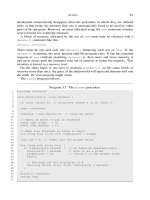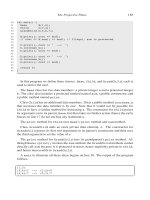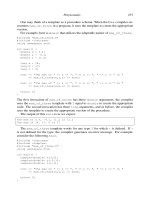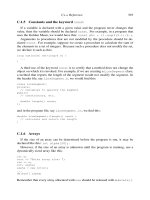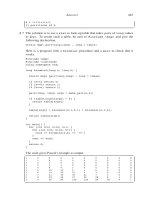Lecture Web technology and online services: Lesson 1 - Introduction
Bạn đang xem bản rút gọn của tài liệu. Xem và tải ngay bản đầy đủ của tài liệu tại đây (1.7 MB, 48 trang )
Introduction to Web Technologies
and e-Services
1
Lecture contents
1.
2.
3.
4.
5.
6.
7.
Internet, Web
HTTP
URL
Web Browser
Web Application
Web Application Architecture
Web Developer Roadmap
2
Reasonable Questions
• What is the World Wide Web?
• Is it the same thing as the Internet?
• Who invented it?
• How old is it?
• How does it work?
• What kinds of things can it do?
• What does it have to do with programming?
Web ≠ Internet
• Internet: a physical network connecting millions of computers using the
same protocols for sharing/transmitting information (TCP/IP)
• in reality, the Internet is a network of smaller networks
• World Wide Web: a collection of interlinked multimedia documents that are
stored on the Internet and accessed using a common protocol (HTTP)
• Key distinction: Internet is hardware; Web is software along with data,
documents, and other media
• Many other Internet-based applications exist e.g., email, telnet, ftp, usenet,
instant messaging services, file-sharing services, …
(A Very Brief) History of the Internet
• The idea of a long-distance computer network traces back to early 60's
• Joseph Licklider at M.I.T. (a “time-sharing network of computers”)
• Paul Baran at Rand (tasked with designing a “survivable” communications system that could
maintain communication between end points even after damage from a nuclear attack)
• Donald Davies at National Physics Laboratory in U.K.
• In particular, the US Department of Defense was interested in the development of
distributed, decentralized networks
• survivability (i.e., network still functions despite a local attack)
• fault-tolerance (i.e., network still functions despite local failure)
• contrast with phone system, electrical system which are highly centralized services
The Internet
• In 1969, Advanced Research Project Agency funded the
ARPANET
• Connected computers at UC Los Angeles, UC Santa Barbara, Stanford
Research Institute, and University of Utah
• Allowed researchers to share data, communicate
• 56Kb/sec communication lines (vs. 110 b/sec over phone lines)
• Technical origin
• One of earliest attempts to network heterogeneous, geographically
dispersed computers
• Email first available on ARPANET in 1972 (and quickly very popular!)
The Internet
The 6 supercomputer centers connected
by the early NSFNET backbone
•Open-access networks
• Regional university networks (e.g., SURAnet)
• CSNET for CS departments not on ARPANET
•NSFNET (1985-1995)
• Primary purpose: connect supercomputer centers
• Secondary purpose: provide backbone to connect regional
networks
Internet Growth
• Throughout the 70's, the size of the ARPANET doubled every year
• First ARPANET e-mail sent in 1971
• Decentralization mades adding new computers easy
• TCP/IP developed in the mid 1970s for more efficient packet routing
• Migration of ARPANET to TCP/IP completed 1 january, 1983
• ~1000 military & academic host computers connected by 1984
• In 80‘s, U.S. government took a larger role in Internet development
• Created NSFNET for academic research in 1986
• ARPANET was retained for military & government computers
• By 90's, Internet connected virtually all colleges & universities
• Businesses and individuals also connecting as computing costs fell
• ~1,000,000 computers by 1992
• In 1992, control of the Internet was transferred to a non-profit organizations
• Internet society: Internet engineering task force, Internet architecture board, Internet assigned number authority, World-wide-web
consortium (W3C)
...
Internet Growth (cont.)
• Internet has exhibited exponential growth, doubling in
size every 1-2 years (stats from Internet Software
Consortium)
World Top 20 Countries in Internet Consumption
at December 31, 2018
(A Very Brief) History of the Web
• The idea of hypertext (cross-linked and inter-linked documents) traces back to
Vannevar Bush in the 1940's
• Online hypertext systems began to be developed in 1960’s
• e.g., Ted Nelson and Andy Van Dam's hypertext editing system (HES), Doug Englebert's NLS
(on-line system)
• In 1987, Apple introduced hypercard (a hypermedia system that predated the WWW)
• In 1989, Tim Berners-lee at the European particle physics laboratory (CERN) designed a hypertext system for
linking documents over the internet
• Designed a (non-wysiwyg) language for specifying document content
• Evolved into hypertext markup language (HTML)
• Designed a protocol for downloading documents and interpreting the content
• Evolved into hypertext transfer protocol (HTTP)
• Implemented the first browser -- text-based, no embedded media
The web was born!
History of the Web (cont.)
• The Web was an obscure, European research tool until 1993
• In 1993, Marc Andreessen and Eric Bina (at the National Center for Supercomputing Applications, a
unit of the University of Illinois) developed Mosaic, one of the early graphical Web browsers that
popularized the WWW for the general public (Erwise was the first one, ViolaWWW the second)
• The intuitive, clickable interface helped make hypertext accessible to the masses
• Made the integration of multimedia (images, video, sound, …) much easier
• Andreessen left NCSA to found Netscape in 1994
• Cheap/free browser further popularized the Web (75% market share in 1996)
• In 1995, Microsoft came out with Internet Explorer
• Opera web browser released in 1996
•
Netscape bought by AOL in 1998 for US$4.2 billion in stock
•
Firefox web browser, version 1.0, released in 2004
•
Google Chrome released in 2008
• Today, the Web is the most visible aspect of the Internet
History of the Web (cont.)
World Wide Web
• The Web is the collection of machines (Web servers) on the
Internet that provide information, particularly HTML documents,
via HTTP.
• Machines that access information on the Web are known as Web
clients. A Web browser is software used by an end user to
access the Web.
Hypertext Transport Protocol (HTTP)
•HTTP is based on the request-response communication
model:
• Client sends a request
• Server sends a response
•HTTP is a stateless protocol:
• The protocol does not require the server to remember anything
about the client between requests.
HTTP
• Normally implemented over a TCP connection (80 is standard port
number for HTTP)
• Typical browser-server interaction:
• User enters Web address in browser
• Browser uses DNS to locate IP address
• Browser opens TCP connection to server
• Browser sends HTTP request over connection
• Server sends HTTP response to browser over connection
• Browser displays body of response in the client area of the
browser window
HTTP Request
•Structure of the request:
• start line
• header field(s)
• blank line
• optional body
HTTP Request
•Structure of the request:
• start line
• header field(s)
• blank line
• optional body
HTTP Request
•Start line
• Example: GET / HTTP/1.1
•Three space-separated parts:
• HTTP request method
• Request-URI (Uniform Resource Identifier)
• HTTP version
HTTP Request
•Start line
• Example: GET / HTTP/1.1
•Three space-separated parts:
• HTTP request method
• Request-URI
• HTTP version
• We will cover 1.1, in which version part of start line must be exactly
as shown
HTTP Request
•Start line
• Example: GET / HTTP/1.1
•Three space-separated parts:
• HTTP request method
• Request-URI
• HTTP version
HTTP Request
•Uniform Resource Identifier (URI)
• Syntax: scheme : scheme-depend-part
• Ex: In />• the scheme is http
• Request-URI is the portion of the requested URI that follows the
host name (which is supplied by the required Host header field)
• Ex: / is Request-URI portion of />
URI
•URI’s are of two types:
• Uniform Resource Name (URN)
o Can be used to identify resources with unique names, such as
books (which have unique ISBN’s)
o Scheme is urn
• Uniform Resource Locator (URL)
o Specifies location at which a resource can be found
o In addition to http, some other URL schemes are https, ftp,
mailto, and file
HTTP Response
•Structure of the response:
• status line
• header field(s)
• blank line
• optional body
23
HTTP Response
•Structure of the response:
• status line
• header field(s)
• blank line
• optional body
24
HTTP Response
•Status line
• Example: HTTP/1.1 200 OK
•Three space-separated parts:
• HTTP version
• status code
• reason phrase (intended for human use)
25



